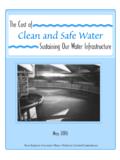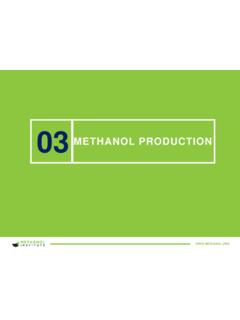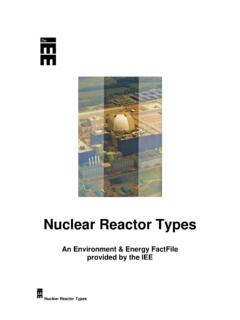Transcription of SEQUENCING BATCH REACTOR DESIGN AND OPERATIONAL …
1 September 2005 Prepared by the NEW ENGLAND INTERSTATE WATER POLLUTION CONTROL COMMISSION116 John Street Lowell, MA 01852-1124 Tel: (978)323-7929 Fax: (978)323-7919 Ronald F. Poltak, Executive DirectorCompact Member StatesConnecticutNew YorkMaineRhode IslandMassachusettsVermontNew HampshireFor additional copies, contact NEIWPCC at the address document is also available for download at on recycled paperSEQUENCINGBATCHREACTORDESIGNANDOPER ATIONALCONSIDERATIONSSEQUENCINGBATCHREAC TORDESIGNANDOPERATIONALCONSIDERATIONSiiT his manual was developed by the New England Interstate Water Pollution ControlCommission. NEIWPCC is a not-for-profit interstate agency, established by an Act ofCongress in 1947, that serves its member states (Connecticut, Maine, Massachusetts, NewHampshire, New York, Rhode Island, and Vermont)
2 By providing coordination, public education,training, and leadership in water management and s technical consultant for this project was Roland Joe Dupuis of would like to thank the following people who contributed their time in reviewing this Slater, MA DEPD avid Boyer, MA DEPNing Chen, MA DEPM argo Webber, MA DEPC harles Conway, NEIWPCCTom Groves, NEIWPCCN elson Thibault, Hoyle, Tanner & AssociatesPaul Clinghan, Hoyle, Tanner & AssociatesAl Curran and staff at Woodard & CurranTom White, NH DESGlen Calltharp, Fluidyne CorpEd Corriveau, PA DEPNew England and New York Regional 104(g) WorkgroupACKNOWLEDGEMENTSNEIWPCC Project OfficersMichael Jennings John MurphyDesign and ProductionRicki Pappo, Enosis The Environmental Outreach GroupEditorial SupportEllen Frye, Enosis The Environmental Outreach GroupiiiiiiFOREWORD.
3 IvINTRODUCTION .. 1 CHAPTER 1: CHARACTERISTICS OF SEQUENCING BATCH REACTORS (SBRss) Common SBR Characteristics .. General .. Basic Treatment Process .. Continuous-Flow Systems .. 6 CHAPTER 2: DESIGN Preliminary/Primary Treatment .. Screening Influent Wastewater .. Influent-Flow Equalization .. Piping for Alkalinity Addition .. Options for Adding Alkalinity.. SEQUENCING BATCH REACTOR .. Basin DESIGN .. Flow-Paced BATCH Operation .. Blower DESIGN .. Decanting .. Bottom Slope .. Post Basin .. Post-Basin Effluent Equalization .. 12 CHAPTER 3: OPERATIONAL Parameters to Be Monitored by the SCADA System .. Cold-Climate Adjustments .. Sampling.
4 Proper Sampling Points .. Parameters to Monitor .. Solids Retention Time (SRT) .. Sludge Wasting .. Troubleshooting .. 15 CHAPTER 4: OTHER On-Site Manufacturer Training .. Wet/Cold-Weather Operating Plans .. 16 REFERENCES.. 17 APPENDIX A: PROCESS CONTROL TESTS AND CALCULATIONS.. 18 APPENDIX B: SEQUENCING BATCH REACTOR TROUBLESHOOTING CHART.. 20 FEEDBACK FORM.. 24 CONTENTSS equencing BATCH REACTOR DESIGN and OPERATIONAL ConsiderationsivThis document is designed to be used by municipalities, engineers, regulators, operators,and other interested parties that use, DESIGN , or are thinking about implementingsequencing BATCH REACTOR (SBR) wastewater treatment systems. This documenthighlights enhancements to the DESIGN and operation of SBRs that will ultimately provide moreeffective wastewater treatment.
5 This document can be used by municipalities in the process ofplanning to upgrade their current operations or reviewing treatment plant options, regulators thatreview SBR designs, and DESIGN is worth noting that many considerations should go into choosing whether or not to implementan SBR treatment system. Decisions should not be based solely on economics; they should alsoinclude process flexibility, ability to meet permit limits, and long-term developing this document, a literature review was conducted to obtain current information onSBRs. Reference information is provided to allow users to obtain source documentation foradditional reference was written to provide general information on SBR enhancements, and therecommendations will not apply to every SBR DESIGN . The document is not meant to be asubstitute for professional advice in situations where it is warranted.
6 SBRs are complextreatment systems that must be addressed on a case-by-case basis. If the information providedhere does not specifically and sufficiently address your problem or concern, consult withindustry professionals, service representatives, or regulatory officials. If you find any mistakes or omissions, please notify NEIWPCC by using the feedback formprovided at the end of this BATCH REACTOR DESIGN and OPERATIONAL Considerations1TR-16 Guides for the DESIGN of Wastewater Treatment Worksis one of the most requesteddocuments produced by the New England Interstate Water Pollution Control , there is a need for supplemental information to address the DESIGN of SEQUENCING batchreactor (SBR) wastewater treatment facilities. SBRs are becoming popular wastewater treatmentoptions in New England and across the country due to their ability to treat varying flow rates andallow control flexibility.
7 In addition, they have a small footprint and are potentially less expensiveto construct and operate. Recognizing the need to address issues associated with the DESIGN and operation of SBR facilities,the Massachusetts Department of Environmental Protection Technical Assistance Section requestedthat NEIWPCC initiate this guide. NEIWPCC began by developing a 40-question survey andsending it to SBR facility operators in New England and New York. The survey questions covereddesign parameters, methods to improve overall plant function, type of discharge permit, and plantset-up. Responses received from the survey verified state concerns that there is no general designthat is common to SBR facilities. After the survey results were compiled, the next step in the development of this guide was to visitfive SBR facilities in New England.
8 The plants visited were chosen based on their uniquecharacteristics, which included: A newly designed plant A plant at full capacity A plant with a varying wastewater flow rate A larger SBR plant with steady flow A plant receiving seasonally varying flows At these facilities, operators, superintendents, DESIGN engineers, and laboratory technicians wereinterviewed. These visits provided valuable first-hand information on how these plants wereoperating and the types of adjustments made to operate at optimal goal of this document is to provide DESIGN considerations and OPERATIONAL information toenhance SBR performance. The guide is also an attempt to optimize SBR DESIGN and describespecific configurations and processes that will enhance treatment BATCH REACTOR DESIGN and OPERATIONAL ConsiderationsSBRs are used all over the world and have been around since the 1920s.
9 With their growing popularity inEurope and China as well as the united states , they are being used successfully to treat both municipaland industrial wastewaters, particularly in areas characterized by low or varying flow , resorts, casinos, and a number of industries, including dairy, pulp and paper, tanneriesand textiles, are using SBRs as practical wastewater treatment alternatives. Improvements in equipment and technology, especially in aeration devices and computer controlsystems, have made SBRs a viable choice over the conventional activated-sludge system. These plantsare very practical for a number of reasons: In areas where there is a limited amount of space, treatment takes place in a single basininstead of multiple basins, allowing for a smaller footprint. Low total-suspended-solid valuesof less than 10 milligrams per liter (mg/L) can be achieved consistently through the use ofeffective decanters that eliminate the need for a separate clarifier.
10 The treatment cycle can be adjusted to undergo aerobic, anaerobic, and anoxic conditions inorder to achieve biological nutrient removal, including nitrification, denitrification, and somephosphorus removal. Biochemical oxygen demand (BOD) levels of less than 5 mg/L can beachieved consistently. Total nitrogen limits of less than 5 mg/L can also be achieved byaerobic conversion of ammonia to nitrates (nitrification) and anoxic conversion of nitrates tonitrogen gas (denitrification) within the same tank. Low phosphorus limits of less than 2 mg/Lcan be attained by using a combination of biological treatment (anaerobic phosphorus-absorbing organisms) and chemical agents (aluminum or iron salts) within the vessel andtreatment cycle. Older wastewater treatment facilities can be retrofitted to an SBR because the basins arealready present.








